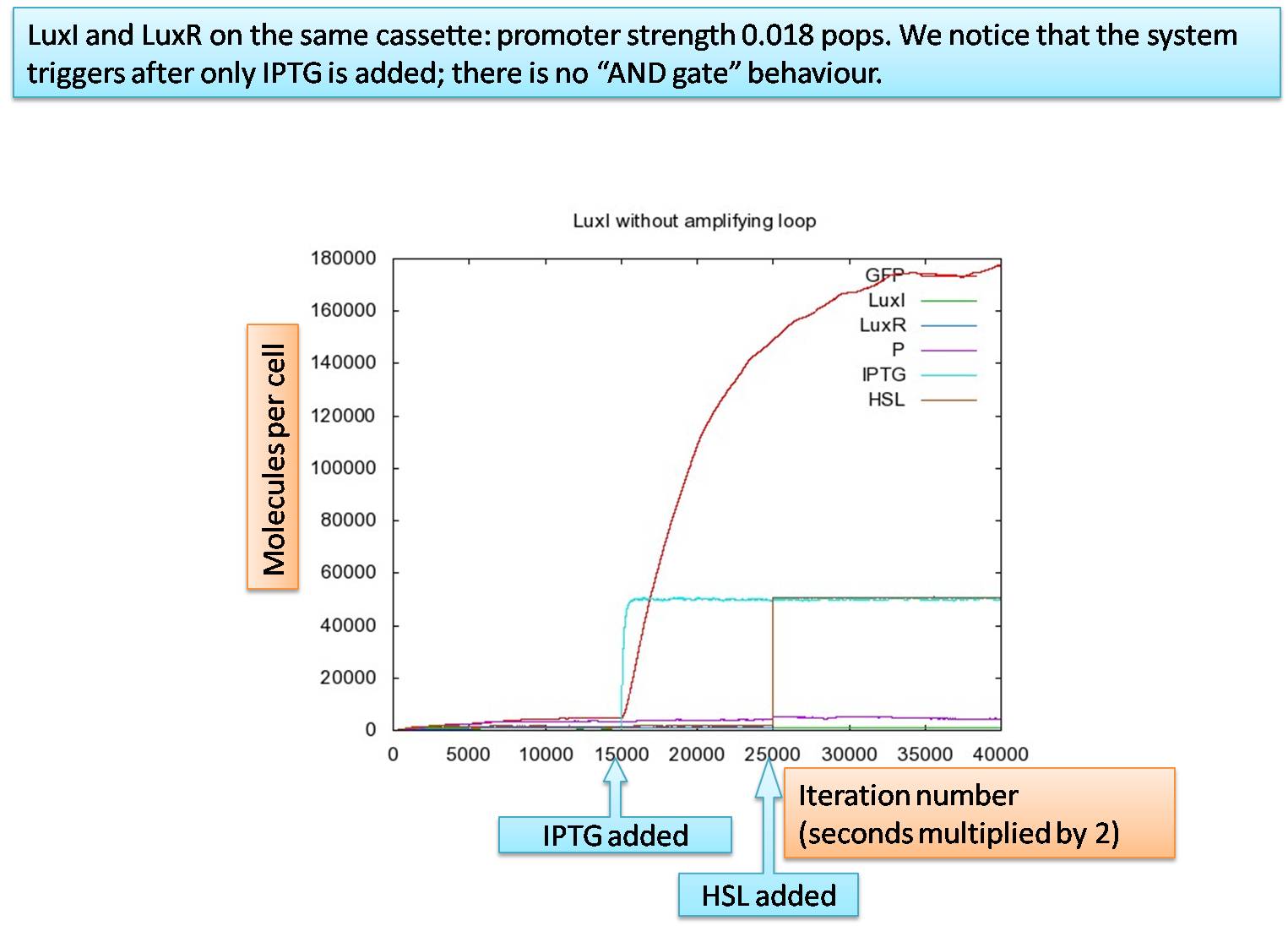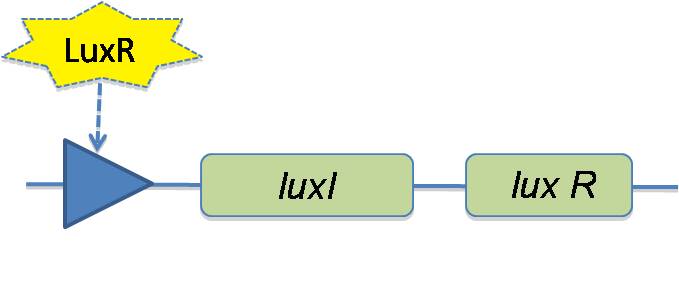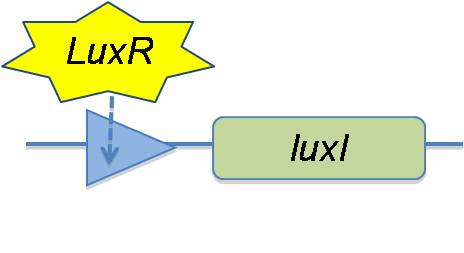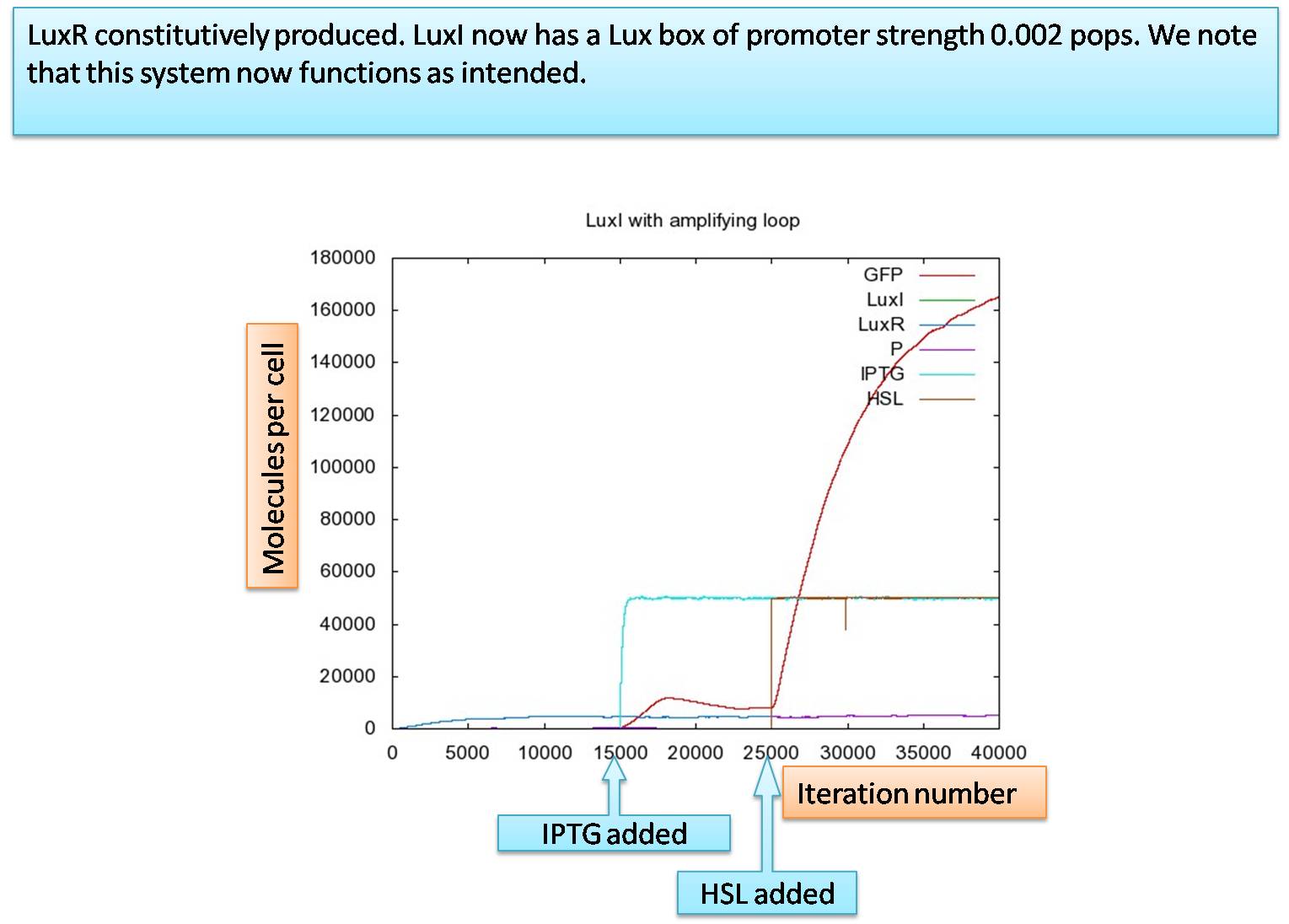Team:Aberdeen Scotland/quorum/invest 1
From 2009.igem.org
University of Aberdeen - Pico Plumber
Contents |
Quorum sensing Revisited
One of the triggering mechanisms of our Pico plumber in order to start glue production, is quorum sensing. Quorum sensing is a response of bacteria to their population density. In the natural system of the marine bacterium Vibro fischeri a small molecule, termed autoinducer, is constantly produced at a low level. This autoinducer molecule (HSL) can freely diffuse in and out the E.Coli membrane. The HSL molecule then diffuses into the surroundings. Other bacteria in the surrounding environment can sense each other via diffusion of HSL through their cell membrane. In the absence of a high density of cells HSL rapidly diffuses into the environment and the HSL concentration is too low to trigger quorum sensing. Quorum sensing is based on a lux-type regulated transcriptional system controlling the production of the autoinducer. In Vibro fischeri, LuxR is encoded on the left side of the operon whereas LuxI is produced on the right side. LuxI together wuth an enzyme always present in the cell, called SAM, together generate in an enzymatic reaction the autoinducer, HSL. The autoinducer HSL together with LuxR form a transcriptional activator for the lux operon, also known as lux box. This complex enables a stronger production of LuxI and LuxR and can been seen as an amplifying loop for LuxI production [1-3].
The issue
In the planning stage of the project, we designed the quorum sensing circuit to have a constant medium production of LuxI in order to activate a lux box on the plasmid where the glue production takes place, in the presence of sufficient cell density:
We are using the lux operon and LacO to give us AND–logic gate to start glue production (here denoted as gene X and gene Y). It is expected that if IPTG is present and there is no HSL within the cell, the promoter starts to produce the glue at a low level. In the presence of HSL and IPTG the promoter starts fabrication of the glue at its maximum level. A possible source of error in our design is that our system might trigger glue production and cell lysis on its own. Having in mind that we have a constitutive medium strength promoter, we need a lower concentration of LuxI. To achieve this LuxI was tagged and a Shine-Dalgarno sequence was used to reuce ribosome affinity to 60%.
The Model
We ran our simulation using the IPTG and HSL concentration outside the cell as inputs. We changed both IPTG and HSL concentration at different times by a switch from low to high to see how the inputs affected the simulation. In our later simulations we simulated both the IPTG and HSL inputs more realistically. We did this applying the sochastic simulation (tau-leap method).
The graph shows the concentration of molecules against the iteration number (which is equivalent to time multiplied by a time-step constant of h=0.5). GFP is a place holder for the glue, P stands for the complex of HSL and LuxR, and finally, IPTG and HSL are the input signals for our cell. IPTG is released at 15000 iterations, whereas HSL diffuses from the outside at 25000 iterations. We want a system to have AND-logic gate, so that both high IPTG and HSL concentration is required for system response. However, it is clearly visible that maximal production of GFP already starts shortly after IPTG gets into the cell. We can conclude from this that the lux-box is activated from within the cell. TThe high production of LuxI and hence, HSl, leads to a high concentration of the HSl-LuxR complex. Moreover, the HSL-LuxR complex is ver stable. This complex cannot diffuse out of the cell as HSL can, so that its concentration can build up very much and hence, activate the lux-box.
Possible Solution
Another option worth to consider is having LuxI and LuxR on the same promoter but with a lux box in front of both.
This is the option that has been explored in the section "Internal Dynamics -> System Investigation -> Section 3, which can be accessed here
Final Solution
In the V.fischeri; where quorum sensing occurs naturally, the production of LuxI is on a very low level before quorum sensing occurs. This means that the HSL concentration is low in the cell, and thus is more likely to diffuse out of the cell rather than combining with LuxR. This results in a low level of HSL-LuxR which is never at a high enough concentration to activate the lux-box. Mimicking the natural system, we suggest putting the LuxI gene on a different promoter additionally regulating LuxR and that the promoter for the LuxI gene by a lux-box.
In the natural system, it is suggested that the lux box constitutively transcripts LuxI at a rate of 1.5*10-4 pops and a maximal transcription 2.0*10-3 pops[1]. Using these values for our system including an amplifying loop for LuxI, we are left with:
The graph shows again an increase of GFP when IPTG enters the cell. However,in the beginning the amount of HSL produced in cell is less than the critical concentration required to activate the lux-box. When HSL is present, the increase in the production of GFP becomes even more pronounced. However, the idea behind the amplifying loop is a latch effect. The system should stay on whenever there is no or very weak HSL present form the outside. Testing this effect by turning off HSL from outside at the 35000 iteration step leaves us with the following graph:
In the presence of IPTG, GFP is produced at a lower level. When HSL enters the cell maximal production is reached. However, as soon as there is no HSL outside the cell, the amount of HSL-LuxR complex decreases indicating a too weak maximal production of LuxI. Thus, the maximal production rate for the promoter in front of LuxI is not strong enough.
However, by changing the maximal production of LuxI to 0.0025 pops it is clearly visible that we loose thehave AND-gate behaviour again.
The latching loop is reached when the constitutive production is set to 0.00001 pops and if the maximal production of the LuxI promoter is set to 0.0035 pops.
Concluding, while LuxR is produced constantly on a medium strong promoter we would need LuxI being formed on a very low constitutive level and in the presents of HSL the production needs to be amplified to a medium strong transcription level.
Conclusion
The original design for the system triggers itself because of a higher production of LuxI than in the natural system. Having LuxI and LuxR both on the same amplifying loop results in a shortage of LuxR that can combine to HSL and start full production of the AND – gate as we can see here
In conclusion, changing the system to have LuxI on an amplifying loop will change the behaviour such that we have an AND-gate to trigger glue production and this is explored in detail here
Bibliography
(1) Goryachev. Systems analysis of a quorum sensing network: Design constraints imposed by the functional requirements, network topology and kinetic constants. BioSystems 2006;83(2-3 SPEC. ISS.):178.
(2) James. Luminescence control in the marine bacterium Vibrio fischeri: An analysis of the dynamics of lux regulation. J.Mol.Biol. 2000;296(4):1127.
(3) Ward JP. Mathematical modelling of quorum sensing in bacteria. IMA. 2001;18:263-292.
(4) Link to stochastic Equations
 "
"








